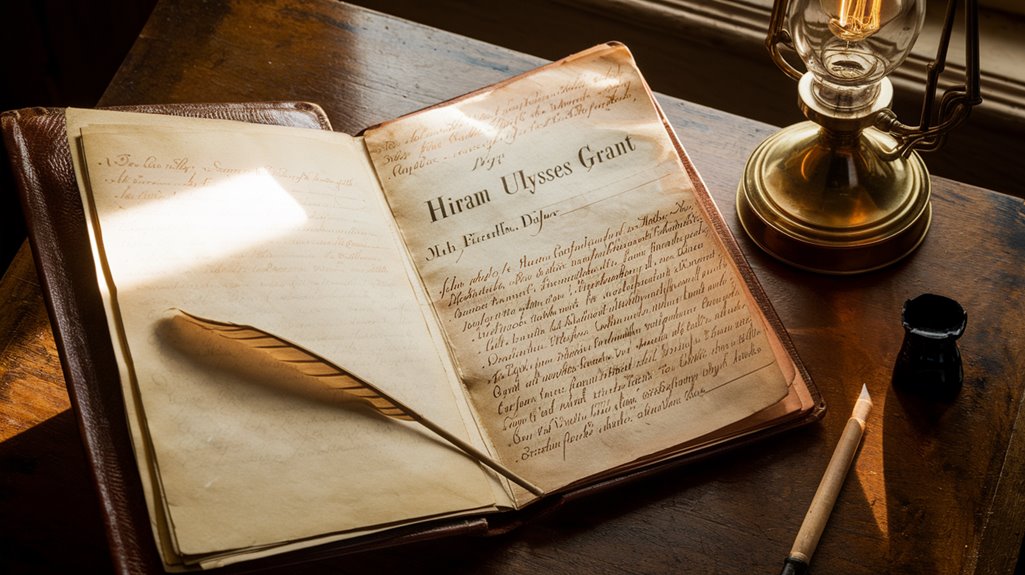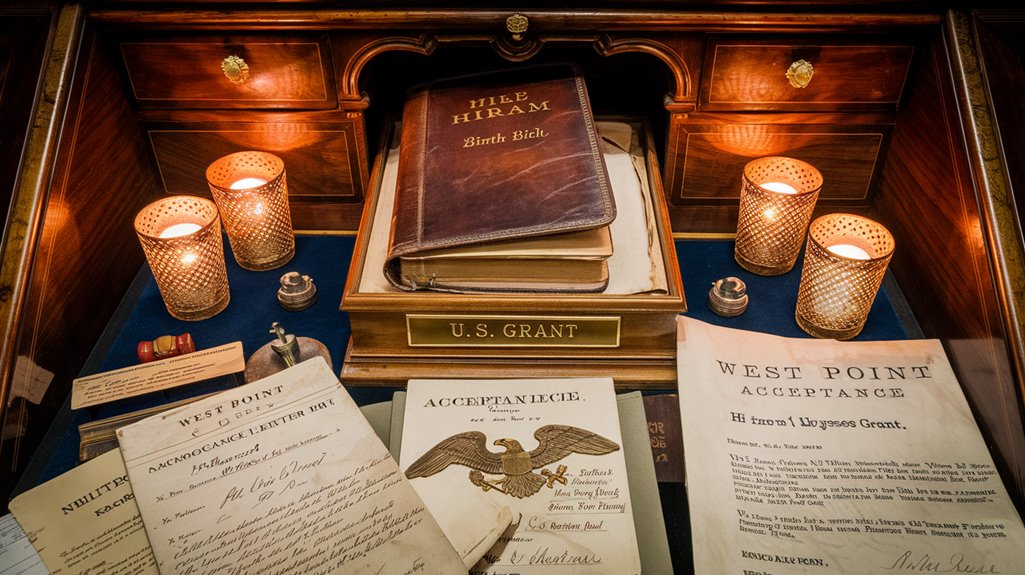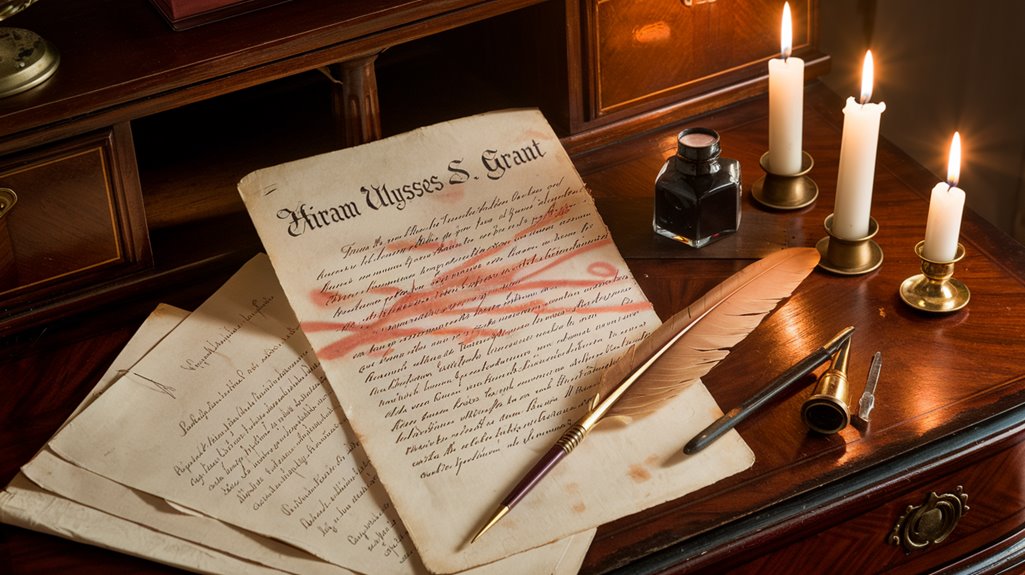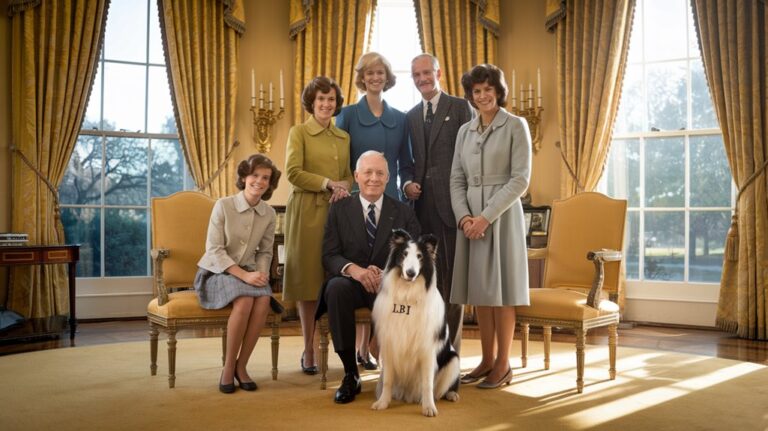Ulysses S. Grant’s Name Wasn’t Actually Ulysses
You might know him as the Civil War hero, the 18th U.S. president, or the face on the fifty-dollar bill, but you probably don't know him by his real name. The man we call Ulysses S. Grant was actually born Hiram Ulysses Grant, and a simple paperwork mistake changed the course of his identity forever. What's even more intriguing is that the famous "S" in his name wasn't part of the original plan—it's a story that reveals how one small error can reshape history.
The Birth Name That Started It All

Names often carry surprising stories, and Ulysses S. Grant's birth name reveals a fascinating tale of familial significance and historical mix-ups.
When you look back to April 27, 1822, in Point Pleasant, Ohio, you'll find that the future president wasn't actually born as Ulysses S. Grant at all.
The name origins tell an interesting story: his parents, Jesse and Hannah Grant, named him Hiram Ulysses Grant. His first name came at the suggestion of his maternal grandfather, while "Ulysses" was chosen through an unusual method – placing ballots in a hat. His mother came from a family of Jacksonian Democrats in Pennsylvania.
Growing up in Georgetown, Ohio, he was the first of six children born to his parents.
The birth significance of his original name would later be altered when he enrolled at West Point, where a clerical error by Congressman Thomas Hamer transformed him into the Ulysses S. Grant we recognize today.
A Congressional Mix-Up Changes History
The path to becoming Ulysses S. Grant began with one of history's most impactful congressional errors. When Congressman Thomas Hamer submitted Grant's West Point nomination paperwork, he mistakenly wrote "Ulysses S. Grant" instead of "Hiram Ulysses Grant."
This simple clerical error would permanently alter Grant's historical legacy.
Upon arriving at West Point, Grant discovered the mix-up but chose to accept his new name rather than risk delaying his education by returning home for a correction. After graduating, he would go on to serve in the military before briefly resigning in 1854 to farm. His leadership would eventually lead him to become the 18th President of the United States.
The change led to:
- His new identity as U.S. Grant, earning him the nickname "Uncle Sam"
- An altered signature that would appear on military orders and presidential documents
- A lasting confusion about his true birth name that persists today
The administrative oversight by Hamer created an unexpected twist that would define Grant's public identity forever.
Why the "S" Made Its Way Into His Name
Understanding how the "S" found its way into Grant's name requires looking at his mother's maiden name, Simpson, which Congressman Thomas Hamer used when completing Grant's West Point application.
When Hamer didn't know Grant's middle name, he simply inserted "S" as a placeholder, drawing from the family's maternal name origins.
You'll find it interesting that Grant initially resisted this change, signing his early letters as "U. H. Grant." His arrival at West Point in September 22, 1839 marked the beginning of this naming transition.
Grant was born as Hiram Ulysses Grant, a name he carried until his West Point nomination changed everything.
However, the military's bureaucracy had other plans. Once West Point officially recorded him as "Ulysses S. Grant" in 1839, the name stuck.
The historical significance of this simple clerical error can't be understated – it transformed Grant's identity permanently, creating the initials "U.S. Grant" that would become synonymous with the future Civil War general and president.
The West Point Application That Sealed His Fate
When young Ulysses received his West Point appointment in 1839, a seemingly minor clerical decision would alter his identity forever.
During the application process, Congressman Thomas L. Hamer submitted Grant's paperwork with an incorrect name: "Ulysses S. Grant."
Though Grant had intended to register as Ulysses Hiram Grant, the mistake would stick with him throughout his military career and beyond. He proved himself to be an exceptional student in mathematics and horsemanship at the academy. His aggressive military style would later make him one of Lincoln's most trusted commanders in battle.
Key aspects of this fateful application include:
- Hamer used "S" for Simpson, Grant's mother's maiden name
- The official West Point documents couldn't be amended once submitted
- Grant accepted the new name rather than fight the bureaucracy
The 17-year-old's destiny was sealed by this paperwork error, and he carried the name through his graduation in 1843, his military service, and eventually, his presidency.
How Grant Embraced His New Identity

Despite his initial attempts to correct the clerical error at West Point, young Grant quickly embraced his new identity as Ulysses S.
You'll find it fascinating that his identity transformation happened quite naturally. While he briefly tried signing letters as U.H. Grant, he soon accepted the change completely. His fellow cadets even nicknamed him "Uncle Sam" due to his patriotic initials, U.S. Grant. The name stuck, and you can trace its historical significance throughout his illustrious military and political career. In 1844, Grant expressed confusion about what the "S" in his name actually stood for. After graduating from West Point in 1843, he embarked on his military journey that would shape American history.
You won't find any evidence of Grant resisting the change or reverting to his birth name, Hiram Ulysses. Instead, he consistently used Ulysses S. Grant in all official and personal documents.
The name that started as a simple mistake became the identity by which you now know this legendary American figure.
The Long-Lasting Impact of a Clerical Error
A simple clerical error at West Point shaped American history in an unexpected way. When a benefactor mistakenly listed Hiram Ulysses Grant as "Ulysses Simpson Grant" on his application, they inadvertently created one of history's most memorable names. After graduating ranked 21st of 39 in his class at West Point, Grant fully embraced his new identity.
This clerical error had far-reaching consequences for historical accuracy, as you'll find Grant's incorrect name throughout countless documents and records.
While such mistakes might seem trivial today, this particular one stuck with Grant throughout his illustrious career. You'll find his legacy preserved under the name U.S. Grant, though it wasn't his birth name.











